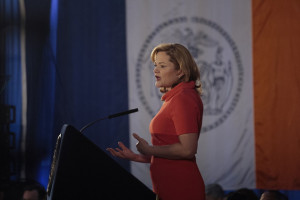
Council Speaker Melissa Mark-Viverito at her State of the City address. (Photo: William Alatriste/NYC Council as reported in the New York Observer)
Despite the welcomed statewide “traffic court amnesty” in California, it remains clear that municipal governments are leading the way in providing civil justice leadership. The latest example comes from the Big Apple, where the city council has voted to create an “Office of Civil Justice” to connect poor people facing housing and other issues with attorneys.